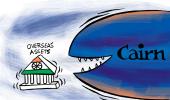Arguing that the recent elevation in retail inflation is not structural but supply-driven and therefore potentially transitory, a foreign brokerage report has forecast that the benign interest rate regime will continue at least until next June.

The assessment comes a day ahead of the third bimonthly monetary policy review on Friday wherein it's widely expected that the monetary authority will leave the key rates unchanged at 4 per cent even though the consumer prices have been on remaining above 6 per cent since May and crude prices have been north of $70 a barrel for months.
“We think the sticky elevated inflation is not a structural issue.
"We expect the upside retail inflation surprise over the past few months to be temporary, more supply-driven and, thus, potentially transitory,” UBS Securities India economist Tanvee Gupta Jain said in a report on Thursday.
However, she pencilled in CPI inflation averaging at 5.5 per cent in FY22 with core inflation slightly above 6 per cent but begin to trend down and average at 4.5 per cent for FY23.
Yet she expects the monetary policy committee to leave the repo rate unchanged at least until June 2022 to ensure the economic recovery is secure, even if inflation overshoots the medium-term target of 4 per cent in the interim.
She expects CPI to edge lower in FY23 to 4.5 per cent, assuming the central bank gradually starts unwinding its ultra-easy policy settings as the economic recovery gains momentum.
While the brokerage expects the policy normalisation to begin from late FY22, it thinks liquidity surplus recalibration can begin sooner.
“This will have the 10-year yields to grind to 6.5 per cent by end-FY22 and to rise to 6.75-7 per cent by end-FY23.”
Five years of sustained high inflation during FY09-FY13 had created a widespread view that inflation is a structural problem.
Since RBI adopted an inflation targeting regime from April 2016, inflation has averaged close to 4 per cent pre-pandemic, largely on lower food prices and weaker growth.
Even with more upside than downside risks to our base case of 5.5 per cent for FY22 and 4.5 per cent for FY23, retail inflation is unlikely to pick up strongly, as the negative output gap will persist well into the next year.
The data indicate most of the CPI inflation increase since the pandemic has been led by higher food and global commodity prices, Gupta-Jain argued.
On the impact of the widening fiscal imbalance and deficit monetisation on inflation, she said, ”currently, we believe the risk of unwanted inflation due to central bank purchases of government debt is limited by the slow expansion of credit, along with excess capacity in the economy due to weak demand conditions as income levels remain low/stagnant”.
She also does not think the negative real interest rates widen macro stability risks again, as unlike in the past, in this cycle of high inflation, household savings has actually gone up despite low interest rates, primarily due to pandemic-induced uncertainty.
Therefore, she expects in the short term, negative interest rates will help reduce the scarring caused by the pandemic by boosting growth, income and employment.
But she is quick to add that the negative interest rates need to be reversed over an extended period to ensure financial stability.
She also expects both the inflation driven by rising prices of crude (9 per cent weight in the CPI basket) and food (46 per cent weight in the CPI basket), to have only a transitory impact as give way to supportive base effects for disinflation.
Photograph: Adnan Abidi/Reuters











 © 2025
© 2025